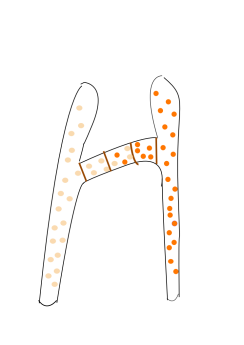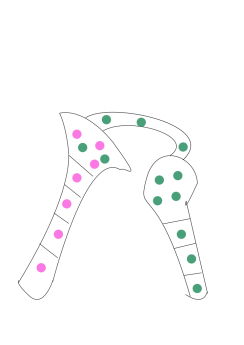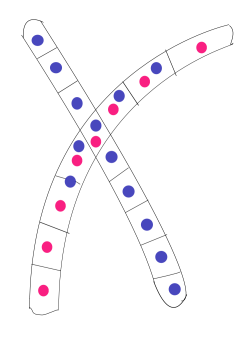
Mating in fungi
Encyclopedia
Mating in fungi is a complex process governed by mating type
s. Research on fungal mating has focused on only a few model species. Since not all of the fungi reproduce sexually and many that do are isogamous
, the terms male and female do not apply to this kingdom. Homothallic species are able to mate with themselves, while in heterothallic species only isolates of opposite mating types can mate.
Mating between isogamous fungi may consist only of a transfer of nuclei from one cell to another. Vegetative incompatibility within species often prevent a fungal isolate from mating with another isolate. Isolates of the same incompatibility group do not mate or mating does not lead to successful offspring. High variation has been reported including same chemotype mating, sporophyte
to gametophyte mating and biparental transfer of mitochondria.
. The mating type genes are located in homeobox
and encode enzyme
s for production of pheromone
s and pheromone receptors
. Sexual reproduction thereby depends on pheromones produced from variant allele
s of the same gene
. Since sexual reproduction takes place in haploid organisms, it cannot proceed until complementary genes are provided by a suitable partner through cell or hyphal fusion. The number of mating types depends on the number of genes and the number of alleles for each.
Depending of the species, sexual reproduction takes place through gamete
s or hyphal fusion. When a receptor on one haploid detects a pheromone from a complementary mating type, it approaches the source through chemotropic
growth or chemotactic
movement if it is a gamete.
 A zygomycete hypha grows towards a compatible mate and they both form a bridge, called a progametangia, by joining at the hyphal tips via plasmogamy
A zygomycete hypha grows towards a compatible mate and they both form a bridge, called a progametangia, by joining at the hyphal tips via plasmogamy
. A pair of septa forms around the merged tips, enclosing nuclei from both isolates. A second pair of septa forms two adjacent cells, one on each side. These adjacent cells, called suspensor
s provide structural support. The central cell is destined to become a spore. The nuclei join in a process called karyogamy
to form a zygote
.
 As it approaches a mate, a haploid sac fungus develops one of two complementary organs, a "female" ascogonium or a "male" antheridium. These organs resemble gametangia except that they contain only nuclei. A bridge, the trichogyne forms, that provides a passage for nuclei to travel from the antheridium to the ascogonium. A dikaryote grows from the ascogonium, and karyogamy
As it approaches a mate, a haploid sac fungus develops one of two complementary organs, a "female" ascogonium or a "male" antheridium. These organs resemble gametangia except that they contain only nuclei. A bridge, the trichogyne forms, that provides a passage for nuclei to travel from the antheridium to the ascogonium. A dikaryote grows from the ascogonium, and karyogamy
occurs in the fruiting body.
 In club fungi
In club fungi
, cells from compatible hyphae fuse upon contact. The donor nuclei divide and travel from cell to cell of the receiver hypha. Septa open to allow the passage. The exchange may or may not be reciprocal. As with sac fungi, karyogamy is deferred until a fruiting body forms.
Mating type
Mating types occur in eukaryotes that undergo sexual reproduction via isogamy. Since the gametes of different mating types look alike, they are often referred to by numbers, letters, or simply "+" and "-" instead of "male" and "female." Mating can only take place between different mating...
s. Research on fungal mating has focused on only a few model species. Since not all of the fungi reproduce sexually and many that do are isogamous
Isogamy
Isogamy is a form of sexual reproduction that involves gametes of similar morphology , differing only in allele expression in one or more mating-type regions...
, the terms male and female do not apply to this kingdom. Homothallic species are able to mate with themselves, while in heterothallic species only isolates of opposite mating types can mate.
Mating between isogamous fungi may consist only of a transfer of nuclei from one cell to another. Vegetative incompatibility within species often prevent a fungal isolate from mating with another isolate. Isolates of the same incompatibility group do not mate or mating does not lead to successful offspring. High variation has been reported including same chemotype mating, sporophyte
Sporophyte
All land plants, and some algae, have life cycles in which a haploid gametophyte generation alternates with a diploid sporophyte, the generation of a plant or algae that has a double set of chromosomes. A multicellular sporophyte generation or phase is present in the life cycle of all land plants...
to gametophyte mating and biparental transfer of mitochondria.
Mating type
A picture of the mating type mechanism has begun to emerge from studies of particular fungi such as yeastSaccharomyces cerevisiae
Saccharomyces cerevisiae is a species of yeast. It is perhaps the most useful yeast, having been instrumental to baking and brewing since ancient times. It is believed that it was originally isolated from the skin of grapes...
. The mating type genes are located in homeobox
Homeobox
A homeobox is a DNA sequence found within genes that are involved in the regulation of patterns of anatomical development in animals, fungi and plants.- Discovery :...
and encode enzyme
Enzyme
Enzymes are proteins that catalyze chemical reactions. In enzymatic reactions, the molecules at the beginning of the process, called substrates, are converted into different molecules, called products. Almost all chemical reactions in a biological cell need enzymes in order to occur at rates...
s for production of pheromone
Pheromone
A pheromone is a secreted or excreted chemical factor that triggers a social response in members of the same species. Pheromones are chemicals capable of acting outside the body of the secreting individual to impact the behavior of the receiving individual...
s and pheromone receptors
Receptor (biochemistry)
In biochemistry, a receptor is a molecule found on the surface of a cell, which receives specific chemical signals from neighbouring cells or the wider environment within an organism...
. Sexual reproduction thereby depends on pheromones produced from variant allele
Allele
An allele is one of two or more forms of a gene or a genetic locus . "Allel" is an abbreviation of allelomorph. Sometimes, different alleles can result in different observable phenotypic traits, such as different pigmentation...
s of the same gene
Gene
A gene is a molecular unit of heredity of a living organism. It is a name given to some stretches of DNA and RNA that code for a type of protein or for an RNA chain that has a function in the organism. Living beings depend on genes, as they specify all proteins and functional RNA chains...
. Since sexual reproduction takes place in haploid organisms, it cannot proceed until complementary genes are provided by a suitable partner through cell or hyphal fusion. The number of mating types depends on the number of genes and the number of alleles for each.
Depending of the species, sexual reproduction takes place through gamete
Gamete
A gamete is a cell that fuses with another cell during fertilization in organisms that reproduce sexually...
s or hyphal fusion. When a receptor on one haploid detects a pheromone from a complementary mating type, it approaches the source through chemotropic
Chemotropism
Chemotropism is growth of organisms such as bacteria and plants, navigated by chemical stimulus from outside of the organism....
growth or chemotactic
Chemotaxis
Chemotaxis is the phenomenon in which somatic cells, bacteria, and other single-cell or multicellular organisms direct their movements according to certain chemicals in their environment. This is important for bacteria to find food by swimming towards the highest concentration of food molecules,...
movement if it is a gamete.
Zygomycete

Plasmogamy
Plasmogamy is a stage in the sexual reproduction of fungi. In this stage, the cytoplasm of two parent mycelia fuse together without the fusion of nuclei, as occurs in higher terrestrial fungi. After plasmogamy occurs, the secondary mycelium forms. The secondary mycelium consists of dikaryotic...
. A pair of septa forms around the merged tips, enclosing nuclei from both isolates. A second pair of septa forms two adjacent cells, one on each side. These adjacent cells, called suspensor
Suspensor
-Fungi:Suspensors are filamentous structural formations employed by Fungi in holding a zygospore between two strains of hyphae.-Plants:Suspensors are also found in plant zygotes in angiosperms in connecting the endosperm to an embryo. During embryo development in angiosperm seeds, normal...
s provide structural support. The central cell is destined to become a spore. The nuclei join in a process called karyogamy
Karyogamy
Karyogamy is the fusion of pronuclei of two cells, as part of syngamy, fertilization, or true bacterial conjugation.It is one of the two major modes of reproduction in fungi...
to form a zygote
Zygote
A zygote , or zygocyte, is the initial cell formed when two gamete cells are joined by means of sexual reproduction. In multicellular organisms, it is the earliest developmental stage of the embryo...
.
Sac fungi

Karyogamy
Karyogamy is the fusion of pronuclei of two cells, as part of syngamy, fertilization, or true bacterial conjugation.It is one of the two major modes of reproduction in fungi...
occurs in the fruiting body.
Club fungi

Basidiomycota
Basidiomycota is one of two large phyla that, together with the Ascomycota, comprise the subkingdom Dikarya within the Kingdom Fungi...
, cells from compatible hyphae fuse upon contact. The donor nuclei divide and travel from cell to cell of the receiver hypha. Septa open to allow the passage. The exchange may or may not be reciprocal. As with sac fungi, karyogamy is deferred until a fruiting body forms.

